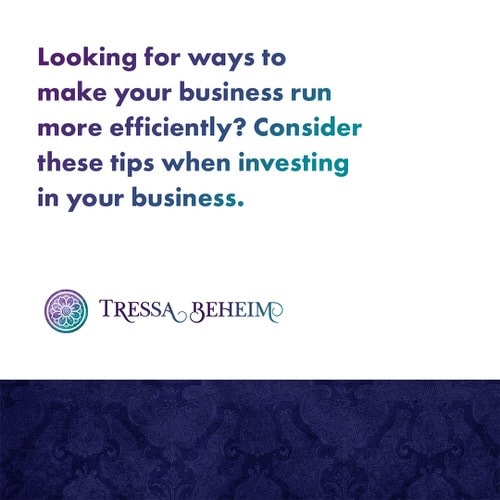Starting a business can be a daunting process. But running your business day after day can be an all-consuming task to the point that it’s easy to lose sight of everything else.
But it doesn’t have to always stay that way – by investing in your business strategically and with right goals in mind, you can run your business with ease.
So let’s talk about some key investments I’ve made in my business that may help you see where investing in your business makes sense.
Investing In Your Business with Professional Development
One of the very first substantial investments I made in business was joining a short four-month mastermind. The investment of $400/month felt like a stretch at the same time but I knew I needed the expert guidance and strategic input to help me manage my rapidly growing client base.
I have continued to participate in the same mastermind each year, even though the investment increased over time. By paying for the right expert mentoring, I’ve saved myself countless hours and an immeasurable amount of headache. This support has allowed me to grow much more strategically than if I was going it alone.
The mastermind has also helped me create and maintain a network of colleagues at a similar place in their businesses. This is equally important to the expert advice because the community support is so helpful when I’m in the weeds of something.
I do want to be clear though – investing in your business through professional development is essential but really doesn’t need to break the bank. While my mastermind is a decent investment each month (and more when I opt to go to the bi-annual retreats) it’s by no means a $25k to $50k mastermind you hear about from time to time. I personally see no need for such a pricey mastermind for myself, nor does it make sense for a lot of the business owners I know.
As with all things, your comfort level when investing in your business will vary but don’t feel like the only way to join a mastermind is to pay $2000 every month. There are fantastic options out there, like Maggie Patterson’s The Agency Mastermind that I’m in, that don’t have to break the bank.
Investing In Your Business Via Financial Management
One of the biggest mistakes I made in my first year of business was not getting the right accounting and bookkeeping support. I used a XERO, a bookkeeping software, which was immensely helpful, but I did all the reconciling and reporting myself. I also didn’t find an accountant straight away which led to a huge tax headache I’m still sorting out nearly three years later.
Investing in your business strategically requires a solid understanding of your numbers. If you’re like most business owners that need some expert guidance and support, one step is finding a monthly bookkeeping solution that provides reporting you actually review and understand. As tempting as it can be to skimp on this, leaving all your bookkeeping to year end (or even several times a year) is a recipe for disaster.
If you don’t know your current numbers it’s virtually impossible to make informed, strategic decisions about your business revenue, expenses and goals.
Similarly, tax support can help you manage the financial health of your business far more effectively than going it alone. It helps you more accurately manage how much you need to pay in taxes and alleviates the stress of trying to figure it all out on your own.
One of the best things I did was get an independent assessment of my books and monthly reports about 18 months into working with my bookkeeper. I felt confident in the support she provided but since I had no way of evaluating the accuracy or effectiveness of the reports simply due to a lack of experience, I wanted a second set of knowledgeable eyes to review them.
I invested in a one-time review by a CFO-level bookkeeper. She confirmed that everything was being done really well and gave some suggestions on a few tweaks we could do to make the reporting more strategic and useful for me. To some, this may seem like an unnecessary expense but to me, it was a perfect example of investing in your business. My confidence in my bookkeeper was 100% validated (which helps immensely) and I got some input on how to make the books even more useful on a day-to-day basis.
Using Premium Tools
Running an online business generally requires a variety of tools and software. The cost of all of these things can certainly add up and make us resistant to spending the money each month. And while I don’t advocate having every possible software out there just because “someone” said you’d need it, I DO recommend investing strategically in the tools you need to run your business effectively.
I’ve written about some of my favorite tools here and here.
My rule of thumb for premium tools is to evaluate a few key things when deciding whether you’re investing in your business or just adding a shiny object.
Here’s what I look at:
- Is this tool essential to the day operations in my business?
- Will it help me reach my business goals this quarter, this year?
- Do I have another tool that does the same thing?
- Will this tool save time or money in some way?
If I can answer yes to most of those questions then I’m much more likely to pull the trigger.
Some of my recent additions were things I technically could get by without, but they offered time saving benefits that would both save money and help grow the business in the long run.
For example, in late 2019 I added Proposify to streamline my proposal process. I had previously resisted sending proposals because it was so time consuming, but I felt like I needed to start sending them consistently when I was charging premium prices.
The addition of that $140 per year has helped close thousands of dollars of business pretty good pay-off right?
This tool is also a good example of making strategic decisions about existing tools.
Proposify includes a contract signing feature which meant I could potentially eliminate HelloSign which is my current contact tool. However, after evaluating Proposify’s tool, I decided I didn’t really like it and it made my current process more complicated. Since the cost of HelloSign is pretty reasonable at $156 per year, the annoyance of using a tool I didn’t like was far outweighed.
I also recently added Harvest so I could bill some clients through that using PayPal business payments. This feature changes only $0.50 per transaction since clients are required to pay from their checking account on PayPal balances. Using this tool is saving me hundreds of dollars each month in merchant fees for an annual cost of $144.
Now I could bill potentially everyone through Harvest (and I may eventually) but for now, the ease of using PayPal for most of my smaller bills plus the faster depositing makes it still worth the extra fees.
The long and short of premium tools is they can be huge time and cost savers when used strategically. So it’s important to evaluate the whole picture before resisting (or impulsively saying yes) a tool.
Pro-Tip: Annual costs for most tools provide extra savings so always consider the annual option wherever possible – especially for tools you’ve already used and know you’ll continue using indefinitely.
Investing In Your Business With a Team
This is perhaps one of the scariest potential ways of investing in your business as well as a costly one — but it can also pay off in a big way again and again. As a service-based business, my team is by far my biggest expense every single month, with me spending approximately 30% of my revenue on my team. At first, this number seemed absolutely insane to me but the reality is I could never generate the revenue I do by serving as many clients as we do without my team.
As long as I stay on top of profit margins and make sure each team member is actually helping to generate revenue in some way, the team is a strategic method of investing in my business. I initially started with primarily billable contractors but as we’ve grown, I’ve added some key people who are decidedly not billable.
Those non-billable hires help run the business so we can carry more clients and bill more as a whole. This means that part of the contractor costs make sense and do contribute to the overall bottom line.
When determining if something is a necessary part of investing in your business, it’s important to focus on the direct and indirect ROI. Some team members have a very obvious tie to revenue while some can be a bit more subtle. Either way though, thoughtful evaluation is important so you don’t overspend or shy away from the strategic use of a team.
Consider Long Term Growth
Whether it’s investing in professional development financial support, premium tools, or a team, spending money on your business can absolutely be scary. But strategic investments are generally always required for growth. So while they can lead to a bit of a short term cash crunches, the overall payoff is important to consider when making a final decision.



